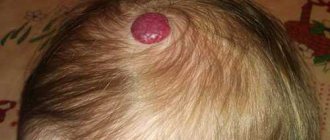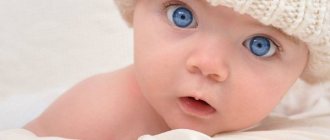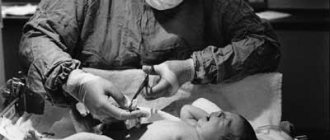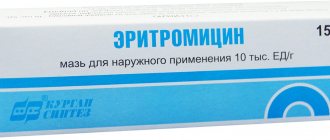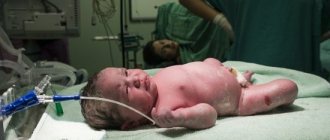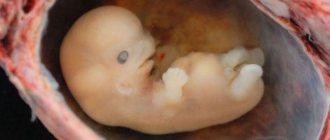Symptoms of dermatitis in an infant
Modern pediatricians identify several types of dermatitis that can develop in an infant: contact, atopic (allergic), diaper dermatitis, seborrheic. They differ in their causes, localization of lesions and their manifestations. Symptoms of the disease depend on its variant. Among the common manifestations, doctors note itching, rashes and redness on the skin, and the baby’s restless state.
Atopic dermatitis
Allergic dermatitis occurs very often in infants. This form of dermatosis manifests itself in the first days of a child’s life and represents inflammatory processes and a violation of the integrity of the skin. Eczema in infants is manifested by the formation of rashes and redness in areas of the epidermis. The child's skin begins to peel off in the buttocks and cheeks. The manifestations of this disease can progress, causing extensive lesions.
The rash of atopic dermatitis is widespread and can be localized on the bends of the elbows and knees, torso, and face. The baby's epidermis becomes inflamed and dry, acquires a reddish tint, and constant itching occurs. If measures are not taken to treat allergic dermatosis in the early stages, wounds and cracks may form, and crusts may appear. If the baby instinctively begins to scratch the pimples, complications may arise, and the disease will become chronic.
- How to find a stolen phone yourself. Are phones found if stolen?
- Fresh porcini mushroom soup
- Pinched nerve in the lower back
The causes of atopic dermatitis in infants can be different. In most cases, the disease occurs due to a hereditary predisposition. Allergens that may be contained in food and the environment also influence the formation of the disease. In some cases, provoking factors are parasitic infections or digestive disorders.
Seborrheic
Seborrheic type dermatitis can form in the first few days of a child's life. The disease occurs under the influence of a certain type of fungus. The disease is localized mainly on the scalp. Seborrheic dermatitis is expressed in an infant in the form of small scabs of a yellowish tint. These formations are often accompanied by a sensation of itching. In cases where a child’s immune system malfunctions, general malaise and diarrhea may be a sign of illness.
Contact
Contact dermatitis affects infants when they directly interact with aggressive substances. Its symptoms arise abruptly, and the disease is characterized by an acute course. Dermatosis manifests itself as the sudden appearance of a rash, redness of the skin, which is accompanied by itching. Weeping crusts are a common occurrence. When they are removed, a secondary infection may occur at the site of inflammation, which will lead to complications. When the provoking factor is eliminated, the symptoms quickly disappear.
- Puzzles for adults: logic riddles with answers
- How to choose a frying pan: which is better, reviews
- Turkey steak - recipes with photos. How to cook juicy turkey meat in the oven, slow cooker and frying pan
Diaper
Improper use of diapers or poor hygiene of an infant can lead to diaper dermatitis. Its symptoms appear on the inner thighs, buttocks or groin area. The disease is characterized by the formation of a rash, irritation, and inflammatory processes, which are accompanied by redness of the epidermis. With a mild degree of the disease, the rashes are minor, and swelling may occur in the affected areas.
Seborrheic dermatitis
Seborrheic dermatitis in a newborn appears as yellow scales covering the scalp. Sometimes such scales can appear behind the baby's ears, as well as in the groin folds, on the legs and arms. As a rule, this coating does not bother the baby. Although severe seborrheic dermatitis may be accompanied by diarrhea or weakness. In some cases, a bacterial infection may accompany the disease. This happens if the baby is poorly cared for. Complications can occur if the child is weakened. Treatment of complicated seborrheic dermatitis is more difficult.
Why seborrheic dermatitis appears is not fully understood. According to scientists, a fungus can cause the disease. There is slightly more of it on the scalp than on other parts of the body.

Inflammation can be triggered by hormonal changes in the baby’s body that occur at the beginning of breastfeeding. Allergies to detergents or food can also cause the disease.
Babies with active sweating are more likely to suffer from seborrheic dermatitis.
Regular overheating of the baby increases the risk of developing the disease.
If the baby does not have an additional infection, getting rid of the crusts is quite simple. During bathing, the baby's steamed head should be smeared with baby oil (olive oil is possible). When the scales are thoroughly saturated with oil, you need to wash your hair with shampoo. After this, use a special brush with natural bristles to carefully comb out the crusts from the scalp. After several such procedures, the crusts will disappear.
Causes
Today, doctors identify the following possible causes of dermatitis in infants:
- Hereditary factor. The disease can appear in a child if one of the parents suffers from or is predisposed to skin diseases.
- Complications for the mother during pregnancy, difficult labor.
- Intrauterine infections suffered by the baby, illnesses of the mother during gestation.
- Treatment of a child with medications after birth and a woman during breastfeeding.
- The occurrence of intestinal disorder or dysbacteriosis in the infant.
- Early start of complementary feeding with foods that are allergens (nuts, citrus fruits, eggs).
- If an infant is bottle-fed, the development of dermatitis may be caused by an unsuitable or poor-quality formula.
- Signs of dermatitis occur when the baby’s hygiene system is incorrect.
- Direct contact of an infant with allergens (chemicals, pollen, house dust).

Kinds
In newborns and infants, the following types of dermatitis are most often diagnosed:
- contact, and there are two types - simple and allergic;
- atopic;
- bullous Ritter;
- seborrheic.

Advice! Symptoms of dermatitis in children are not always typical. Therefore, you should not try to make a diagnosis yourself, relying on a description of the symptoms. Be sure to show your child to a specialist.
Contact
As the name implies, this type of dermatitis occurs after direct contact of an irritating substance with the child’s skin. The reasons for the development of dermatitis in an infant can be:
- clothing containing a large percentage of synthetics or made using low-quality dyes;
- disposable diapers;
- laundry detergents;
- hygiene and cosmetic products;
- poor quality toys.
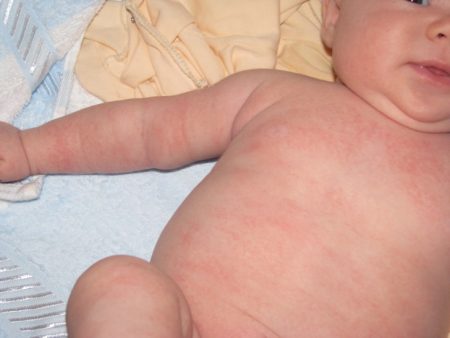
A rash on the skin of a baby with contact dermatitis occurs only in the place where the skin came into contact with the irritant substance. Swelling occurs, the skin becomes very red, and blisters may form.
Advice! The severity of symptoms depends on the age of the child, the area of skin contact with the irritant, and the duration of contact.
With constant interaction with the irritant, the disease becomes chronic, and the skin becomes rougher, begins to peel, and hyperpigmentation may appear. To treat contact dermatitis in infants, it is important to prevent further skin contact with the irritant. For mild damage, this will be enough.
If the symptoms of contact dermatitis are severe, then additional measures are required. Inflamed areas are treated with antiseptic solutions to prevent associated infections. For large areas of contact dermatitis, infants may be prescribed antihistamines.
Advice! Antihistamines should only be used in the treatment of contact dermatitis as prescribed by a doctor. The fact is that many popular drugs are contraindicated for newborns and children in the first year of life.
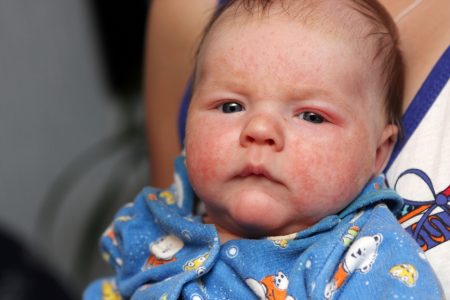
Atopic
Atopic dermatitis in newborns begins to manifest itself from the first days of life. Atopic eczema is characterized by inflammation, redness, peeling and weeping. Most often, the rashes cover the cheeks, as well as on the buttocks and popliteal fossae.
The affected areas may grow, and small spots on the lower cheeks may grow, gradually covering the entire face. The appearance of rashes is accompanied by severe itching. The tendency to develop atopic dermatitis is inherited.
Therefore, if parents have allergic diseases, then their baby is 80% likely to suffer from atopic eczema. An exacerbation of the disease can be provoked by:
- poor nutrition of the mother when breastfeeding;
- use of an inappropriate formula when artificial feeding;
- introducing complementary foods too early;
- incorrect choice of complementary foods;
- the effect of respiratory allergens: house dust, pollen, etc.

The disease is chronic, with periodic exacerbations. With a prolonged course of the inflammatory process, the skin on the cheeks and other affected areas becomes dry, rough and flaky.
Parents should treat the treatment of atopic dermatitis in a child responsibly. It is very important to identify those substances that cause an exacerbation of the process. Most often, these are various food products.
If the child is breastfed, then the nursing mother should follow a hypoallergenic diet. If the baby receives formula, it is necessary to choose a baby food option that does not lead to aggravation and is well tolerated by the baby.
If the baby has already begun to introduce complementary foods, then this should be done as carefully as possible. Each new product should be given literally a quarter teaspoon for the first time.
Then you need to take a 10-day break, during which the child should not receive any new products. If after introducing the product rashes appear on the skin, then you need to exclude this product from the diet.

But it is not always possible to cope with the disease by identifying and eliminating the allergen. It is necessary to consult a specialist to prescribe local and systemic therapy.
Seborrheic
The appearance of soft, easily removable crusts on the head is a sign of seborrhea. This disease is a normal variant in the first six months of a child’s life and, most often, does not require special treatment.
Advice! Seborrheic dermatitis on the scalp (on the scalp) in babies in the first months of life occurs in approximately half of the children in this age group. The disease, as a rule, does not cause physical discomfort and goes away without treatment within 1-2 months.
Seborrhea manifests itself in a child under one year of age by the formation of yellowish crusts on the head. These crusts are easily removed, and after removing the crust, there should be no signs of inflammation on the scalp - redness, swelling.
When crusts appear, pediatricians recommend periodically lubricating the affected skin with an emollient cream (for example, Children's) or oil for caring for the skin of newborns. This allows the crusts to soften, after which they are removed with light touches of a soft brush.
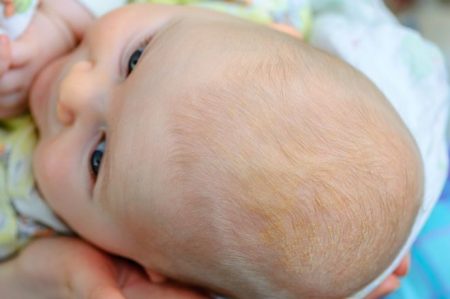
In rare cases, seborrhea in newborns occurs in a severe form, which requires specific treatment. In severe cases, crusts appear not only on the scalp, but also on other areas rich in sebaceous glands.
So, in some babies, seborrheic dermatitis appears on the face, and sometimes spreads to other parts of the body. In this case, the baby should be treated under the guidance of a specialist.
Treatment
The choice of treatment for a child’s dermatitis depends on the type of disease. Doctors prescribe the following methods:
- With the contact type, drug treatment is not required. To relieve symptoms, you only need to protect your baby from the effects of substances that provoked the disease.
- Seborrheic dermatitis can be cured by regularly combing scabs from your baby's skin. It is necessary to wash the child's hair with a special shampoo, Nizoral is considered suitable. After this procedure, the skin should be dried with a towel and treated with ointment or cream.
- You need to start treating diaper dermatitis with the right approach to caring for your baby. Keep his skin dry and clean. When changing the diaper, wash your baby with warm water, gently wipe with soft cloths and lubricate the skin with a hypoallergenic cream or special ointment.
- An effective way to treat atopic dermatitis in infants is complex therapy. It includes identifying the substance that provoked the allergic reaction, changing the mother’s diet, choosing an appropriate formula if the child is bottle-fed, and limiting the baby’s contact with irritants. In addition, problems in the digestive tract are treated with the help of probiotics. Doctors prescribe antihistamines, anti-inflammatory and moisturizing creams and ointments to relieve acute symptoms. If you suspect allergic dermatitis in a baby, you should immediately contact a doctor; you cannot self-medicate.
Ointment
To treat infants, doctors recommend using non-hormonal ointments, since hormone-based drugs are not always suitable and can cause a negative reaction. Among the popular means are the following:
- D-Panthenol - the drug promotes the rapid restoration of delicate children's skin with diathesis, neurodermatitis and other diseases accompanied by peeling, cracks and rashes. Doctors advise using the cream after changing diapers and diapers, and bathing.
- Zinc ointment – has disinfectant, adsorbent and astringent properties. The drug relieves inflammation and irritation, dries out pimples. Contraindication for use is the presence of individual intolerance.
- Skin-cap is a product that can be used for the treatment of adults and children of all ages. The medicine actively fights bacteria and fungi. Helps relieve inflammation and irritation. Dermatoses in young children can be treated with this medication for no more than a month. Use as directed by your doctor, as Skin-Cap may cause allergic reactions.
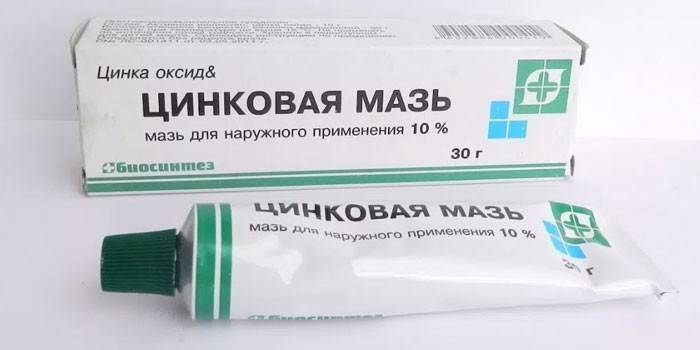
Soy mixtures for atopic dermatitis
If the mother does not breastfeed, then great attention should be paid to the choice of formula when the baby develops atopic dermatitis. These products consist of many components, so you need to determine what caused the allergy. If drinking cow's milk gives a reaction, doctors recommend using soy formula for feeding. They contain vegetable proteins and are enriched with a complex of vitamins and minerals. The product is easily tolerated by the child without causing problems in the digestive system.
Mom's diet
To prevent a recurrence of neurodermatitis in a child, a nursing mother will have to resort to a diet. The nutrition system is based on hypoallergenic products. From the diet you need to exclude foods with a high content of aggressive substances: eggs, cow's milk, chocolate, citrus fruits, seafood. It is forbidden to eat mustard, radish, mayonnaise, horseradish, canned fish, smoked meats, and pickles. Doctors do not recommend drinking a lot of coffee and cocoa, or eating flour products and sweets in large quantities.
Breastfeeding women should include the following foods in their diet:
- dietary boiled meat;
- vegetables, stewed or boiled;
- soups with low-fat broth;
- porridge;
- dairy products;
- bagels, biscuits and wheat bread;
- bananas, watermelons, baked apples.

Atopic dermatitis
The symptoms of atopic dermatitis vary. There are several types of forms of the disease and its manifestations. Weeping blisters may form that eventually crust over, or flaky areas that are very itchy. A rash may appear with thickening of the skin and impaired pigmentation.

Dust, detergents or hygiene products, wool, and dyes in the fabric of children's clothing can cause inflammation.
Imperfect functioning of the gastrointestinal tract can lead to allergies to completely harmless food products.
Hereditary factors play a role in the development of the disease. Children whose parents themselves suffered from atopic dermatitis have a much higher risk of developing inflammation.
The disease can occur as a result of taking medications. For example, after taking antibiotics or immunomodulating drugs.
For atopic dermatitis, all patients are prescribed a hypoallergenic diet. Chicken eggs, wheat and products made from it, dairy products, oatmeal, beef and pork, red vegetables and fruits, and non-local products are removed from the baby’s menu.
An allergist will examine the functioning of the baby’s gastrointestinal tract, perform the necessary tests and prescribe the necessary treatment to correct its functioning.
Prevention
If a child has had dermatitis, there is a chance that the disease will return. To prevent this, the following preventive measures should be taken:
- The baby's clothes should be his size, made of natural fabrics that allow air to pass through well. Buttons, seams and rivets are only allowed on the outside.
- The child needs to be bathed regularly, and his skin should be treated with special creams and oils.
- Cleaning of premises should be carried out without using products that contain chlorine.
- Do not allow your child to come into contact with allergens.
- Consult your doctor about an appropriate diet. The pediatrician's instructions must be strictly followed.
Reasons for appearance
The causes of contact dermatitis include:
- wearing synthetic clothing;
- children's washing powders;
- diapers;
- lotions, shampoos and massage oils;
- toys.
Causes of allergic dermatitis:
- poor nutrition of the child;
- improper nutrition of the mother when feeding the baby with breast milk;
- respiratory allergens, which include: dust, wool, and plant pollen.
Common causes of the disease include:
- predisposition to the disease;
- complicated pregnancy or viral disease during this period;
- drug therapy during pregnancy or in the first days of the baby’s life;
- dysbacteriosis;
- adding chocolate, nuts and citrus fruits to the diet;
- failure to maintain proper care and hygiene.
Manifestation of the disease in the baby’s hair
The cause of the contact variant can be seams on clothing, as well as metal fasteners. This type of illness does not require intensive treatment and goes away in a very short period of time. The skin of a small child is thinner and also more delicate than that of an adult, so clothes should be softer.
The atopic form can be aggravated by poor nutrition of the child, the use of household chemicals, fungal infections, and dysbacteriosis. It is very important to constantly lubricate your skin with moisturizer and not let it remain dry for a long time.
Factors that provoke dermatitis:
- heatwave;
- cold;
- dry air;
- flowering of various plants;
- cosmetics with additives.
In most cases, eliminating the cause of the disease leads to self-limitation of the rash.
Treatment of atopic dermatitis in children
The photographs clearly show the external signs of dermatitis. But its treatment in a child, especially an infant, rarely comes down to just prescribing medications. Infants are offered light treatment , which helps them cope with skin rashes. In this type of treatment, diseased areas of the skin are irradiated with ultraviolet light.
When medicinal treatment, it is important to follow an integrated approach: removal of allergens from the body and the environment, treatment of affected skin areas, general treatment with medications. When exposed to medicinal drugs on the skin:
- Its dryness decreases and itching goes away.
- The water-lipid composition of the skin is restored and its normal condition returns.
- Damaged layers of the epithelium are restored.
- Prevention or treatment of secondary skin infections occurs.
Drug treatment is prescribed by a doctor during a personal examination of the child and depending on the severity of the disease and the age of the patient.
Description of the appearance of the rash
Externally, dermatitis can look different. Sometimes it manifests itself in dryness and flaking of the skin. Most often, rashes appear in the form of redness in various areas of the skin, in the form of small formations, or their merging into a large spot.
If any infection is added to the disease, small wounds and ulcers may appear on the child’s skin. Blisters covered with a yellow crust usually appear on the cheeks of the baby. Also on the face you can see peeling in the eyebrow area and on the scalp, which is called seborrheic dermatitis. Allergic dermatitis can be expressed in the form of small ulcers on the skin, which usually leave wounds.
Examples of dermatitis in infants and newborns can be seen in the photographs below:
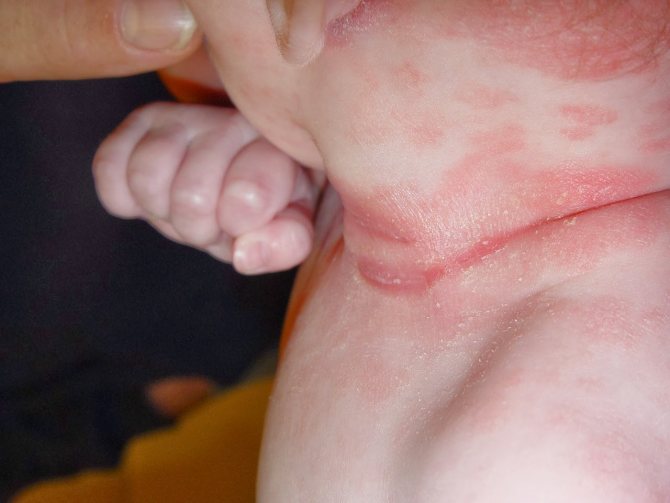
Rash in the form of a line

On the baby's back
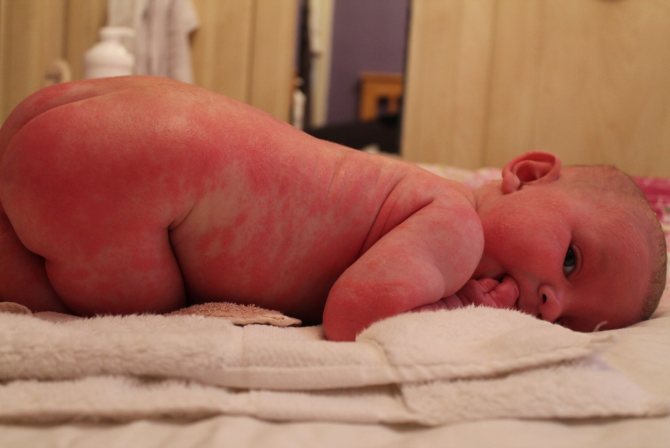
All over the body
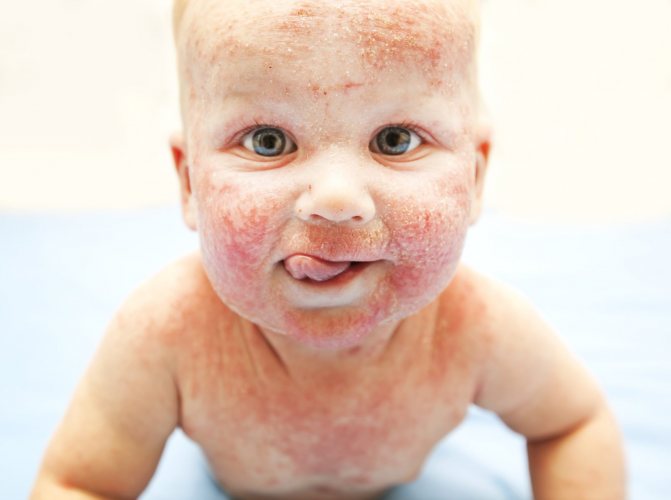
On the face and chest
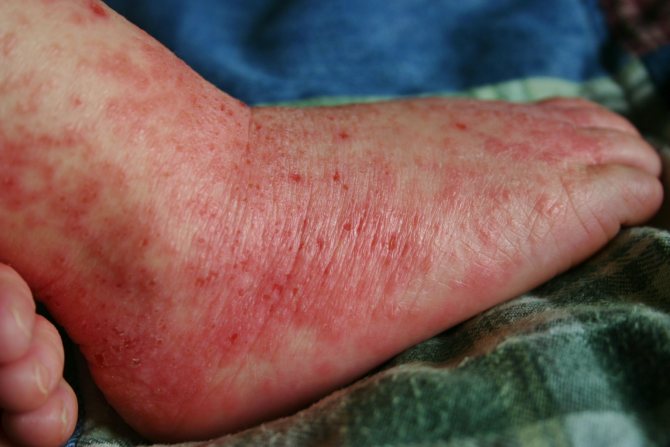
On a leg

Local rash on the arm

